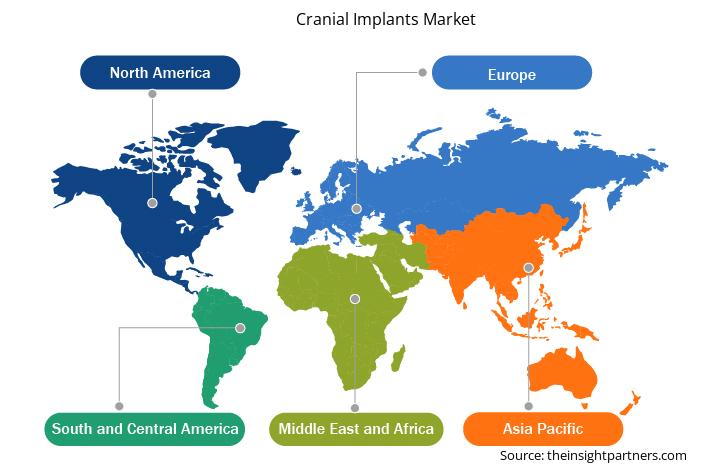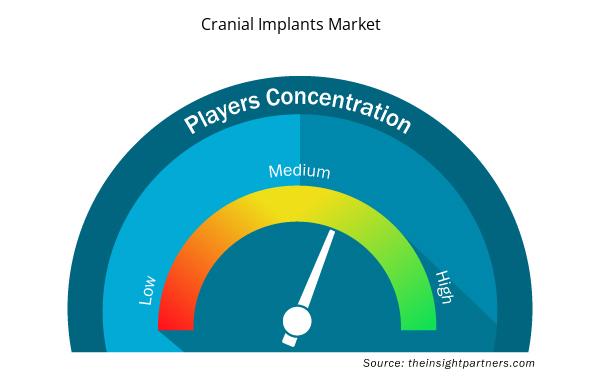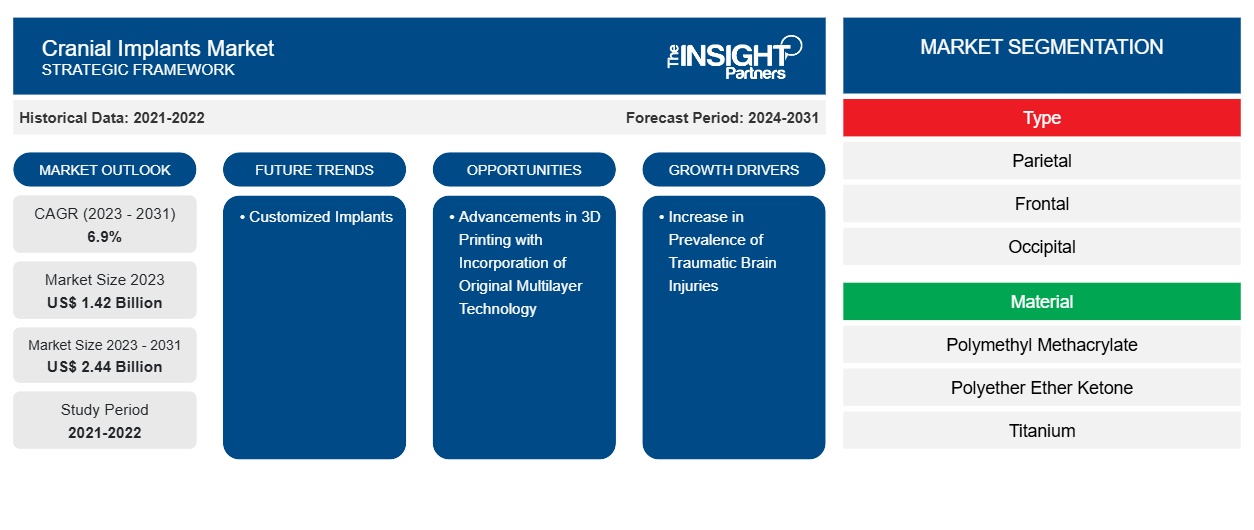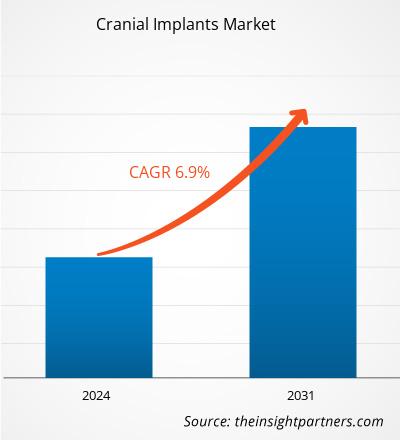Si prevede che la dimensione del mercato degli impianti cranici raggiungerà i 2,44 miliardi di dollari entro il 2031, rispetto agli 1,42 miliardi di dollari del 2023. Si prevede che il mercato registrerà un CAGR del 6,9% nel periodo 2023-2031. È probabile che gli impianti personalizzati introducano nuove tendenze di mercato durante il periodo di previsione.
Analisi di mercato degli impianti cranici
Le lesioni cerebrali traumatiche (TBI) costituiscono uno dei principali problemi di salute pubblica in quanto interrompono il normale funzionamento del cervello a causa di una forza meccanica esterna. Le cause comuni di TBI includono cadute, incidenti automobilistici e infortuni sportivi, che colpiscono principalmente giovani adulti e anziani. I TBI variano da lievi commozioni cerebrali a gravi lesioni che provocano disabilità cognitive, fisiche ed emotive per tutta la vita. Secondo un rapporto pubblicato in The Lancet Neurology Commissions nel 2022, il TBI è una delle principali cause di morte e disabilità correlate a lesioni, che colpisce 55 milioni di persone in tutto il mondo e costa oltre 400 miliardi di dollari ogni anno. Allo stesso modo, secondo la Brain Injury Association di Waterloo-Wellington, i TBI si verificano in 500 persone su 100.000 ogni anno in Canada; oltre 6.000 pazienti diventano permanentemente disabili ogni anno a causa di un TBI. Inoltre, secondo il rapporto Bolt Burdon Kemp 2024, ogni anno nel Paese si verificano circa 10.000-20.000 gravi lesioni cerebrali traumatiche. La domanda di opzioni di trattamento efficaci, in particolare di impianti cranici, è in aumento a causa del crescente numero di casi di TBI. Questi impianti svolgono un ruolo cruciale nel trattamento dei pazienti con gravi lesioni alla testa, proteggendo il cervello da ulteriori traumi e aiutando a ripristinare la funzione protettiva del cranio. Poiché la prevalenza di TBI continua ad aumentare, si prevede che anche la domanda di impianti cranici aumenterà nei prossimi anni.
Panoramica del mercato degli impianti cranici
Il mercato degli impianti cranici è in rapida espansione a causa dell'aumento della prevalenza di TBI e dell'aumento della popolazione anziana. I principali attori che operano nel mercato si stanno concentrando su innovazione e collaborazione per una maggiore disponibilità del prodotto. Tuttavia, il rischio di fallimento dell'impianto ostacola la crescita del mercato degli impianti cranici.
Personalizza questo report in base alle tue esigenze
Riceverai la personalizzazione gratuita di qualsiasi report, comprese parti di questo report, o analisi a livello nazionale, pacchetto dati Excel, oltre a usufruire di grandi offerte e sconti per start-up e università
- Scopri le principali tendenze di mercato in questo rapporto.Questo campione GRATUITO includerà analisi di dati che spaziano dalle tendenze di mercato alle stime e alle previsioni.
Driver e opportunità del mercato degli impianti cranici
L'aumento della popolazione anziana alimenta la crescita del mercato
Secondo il Population Reference Bureau, si prevede che il numero di americani di età pari o superiore a 65 anni passerà da 58 milioni nel 2022 a 82 milioni entro il 2050, segnando un aumento del 47%. Secondo i dati pubblicati dal Fraser Institute, la quota della popolazione canadese di età pari o superiore a 65 anni è aumentata dal 14% nel 2010 al 19% nel 2022 e si prevede che raggiungerà ulteriormente il 22,5% entro il 2030. L'invecchiamento della popolazione sta aumentando rapidamente in Brasile. Secondo i dati della Pan American Health Organization (PAHO), il Brasile ha circa 30 milioni di persone di età pari o superiore a 60 anni (vale a dire, il 13% della popolazione del paese). Si prevede inoltre che la popolazione di questa fascia d'età raggiungerà circa 50 milioni (ovvero il 24% della popolazione totale) entro il 2030. Le statistiche Eurostat indicano che oltre un quinto (21,1%) della popolazione europea aveva 65 anni o più nel 2022. Secondo un articolo di UpToDate Inc. pubblicato nell'agosto 2021, il tasso di incidenza dell'epilessia aumenta con l'età ed è più alto tra i pazienti di età pari o superiore a 75 anni.
Gli anziani sono più vulnerabili alle cadute e agli incidenti che aumentano il rischio di traumi cranici. L'invecchiamento, unito a una maggiore prevalenza di malattie neurologiche , sta spingendo la domanda di impianti cranici. L'intervento chirurgico è spesso necessario per riparare i crani fratturati dopo tali lesioni e gli impianti cranici sono essenziali per ripristinare l'integrità strutturale del cranio e proteggere il cervello. I sistemi sanitari si stanno concentrando sul miglioramento della qualità della vita degli anziani, con conseguente maggiore adozione di questi impianti negli interventi chirurgici per traumi e ricostruttivi.
Progressi nella stampa 3D con l'incorporazione della tecnologia multistrato originale per creare opportunità redditizie nel mercato
La stampa 3D, nota anche come produzione additiva, consente la creazione di impianti cranici altamente personalizzati e specifici per il paziente che offrono una migliore vestibilità e funzionalità rispetto agli impianti tradizionali. La progettazione e la produzione di impianti cranici si sono evolute con il progresso di questa tecnologia, consentendo una replica precisa della geometria del cranio di un individuo, il che riduce il rischio di complicazioni chirurgiche e migliora i risultati del recupero. L'integrazione della tecnologia multistrato nella stampa 3D migliora ulteriormente questi vantaggi. Questa tecnologia consente la creazione di impianti con più strati, ciascuno progettato con proprietà diverse su misura per funzioni specifiche. Ad esempio, uno strato potrebbe essere progettato per la resistenza strutturale, mentre un altro potrebbe concentrarsi sulla biocompatibilità o sulla flessibilità. Gli impianti multistrato stampati in 3D possono migliorare l'osteointegrazione (crescita ossea nell'impianto), ridurre il rischio di rigetto dell'impianto e offrire una protezione superiore per il cervello.
La stampa 3D consente tempi di produzione più rapidi, costi di fabbricazione inferiori e maggiore flessibilità nell'adattamento a complesse deformità craniche. Questi progressi non solo migliorano i risultati per i pazienti, ma riducono anche il costo complessivo del trattamento, rendendo gli impianti cranici più accessibili a una popolazione di pazienti più ampia. Di conseguenza, i progressi della stampa 3D con l'integrazione della tecnologia multistrato originale, che offre una migliore precisione chirurgica, complicazioni ridotte e migliori prestazioni a lungo termine, presentano opportunità significative per il mercato degli impianti cranici.
Analisi della segmentazione del rapporto di mercato degli impianti cranici
I segmenti chiave che hanno contribuito alla derivazione dell'analisi di mercato degli impianti cranici sono tipologia, materiale e utente finale.
- In base al tipo, il mercato degli impianti cranici è segmentato in parietale, frontale, occipitale, temporale e sfenoide. Il segmento parietale ha detenuto la quota maggiore del mercato nel 2023.
- In termini di materiale, il mercato degli impianti cranici è suddiviso in polimetilmetacrilato, polietilene poroso e titanio. Il segmento del polimetilmetacrilato ha dominato il mercato nel 2023.
- In termini di utente finale, il mercato degli impianti cranici è suddiviso in ospedali, centri traumatologici e centri chirurgici ambulatoriali. Il segmento ospedaliero ha dominato il mercato nel 2023.
Analisi della quota di mercato degli impianti cranici per area geografica
L'ambito geografico del rapporto di mercato sugli impianti cranici si concentra principalmente su cinque regioni: Nord America, Asia Pacifico, Europa, Sud e Centro America e Medio Oriente e Africa. In termini di fatturato, il Nord America ha dominato il mercato nel 2023. Si stima che dominerà il mercato globale durante il periodo di previsione. Gli Stati Uniti sono il più grande mercato di impianti cranici al mondo e si stima che domineranno il mercato anche durante il periodo di previsione. I TBI sono la causa di un numero significativo di decessi e visite al pronto soccorso negli Stati Uniti. Secondo i dati dei Centers for Disease Control and Prevention (CDC), gli Stati Uniti hanno registrato oltre 69.000 decessi correlati a TBI nel 2021, ovvero circa 190 decessi al giorno. Nel 2020 nel paese si sono verificati circa 214.110 ricoveri ospedalieri correlati a TBI. I TBI sono tra le cause più significative di deformità craniche, che richiedono un intervento chirurgico tramite impianti, contribuendo a una maggiore domanda di impianti cranici. Secondo le statistiche sugli infortuni sportivi della Johns Hopkins University, circa 30 milioni di bambini e adolescenti praticano qualche forma di sport negli Stati Uniti e più di 3,5 milioni di bambini di età pari o inferiore a 14 anni subiscono infortuni sportivi ogni anno. Questi infortuni e cadute sono le cause comuni di TBI, portando a una maggiore domanda di impianti cranici per interventi chirurgici e ricostruzioni.
Ad aprile 2024, 3D System ha ricevuto l'autorizzazione 510(k) della Food and Drug Administration (FDA) statunitense per il suo impianto cranico VSP PEEK. L'uso di una soluzione di produzione additiva consente la creazione di impianti cranici specifici per il paziente con un utilizzo di materiale fino all'85% inferiore rispetto a impianti simili prodotti con lavorazione tradizionale, con conseguenti notevoli risparmi sui costi di materie prime costose, come il PEEK impiantabile. Inoltre, ad aprile 2024, Longeviti Neuro Solutions (un'azienda di neurotecnologia con sede nel Maryland) ha ottenuto un brevetto statunitense per il suo impianto cranico traslucido protesico ClearFit, destinato all'uso durante le procedure neurochirurgiche.
Approfondimenti regionali sul mercato degli impianti cranici
Le tendenze regionali e i fattori che influenzano il mercato degli impianti cranici durante il periodo di previsione sono stati ampiamente spiegati dagli analisti di Insight Partners. Questa sezione discute anche i segmenti e la geografia del mercato degli impianti cranici in Nord America, Europa, Asia Pacifico, Medio Oriente e Africa e America centrale e meridionale.

- Ottieni i dati specifici regionali per il mercato degli impianti cranici
Ambito del rapporto di mercato sugli impianti cranici
| Attributo del report | Dettagli |
|---|---|
| Dimensioni del mercato nel 2023 | 1,42 miliardi di dollari USA |
| Dimensioni del mercato entro il 2031 | 2,44 miliardi di dollari USA |
| CAGR globale (2023-2031) | 6,6% |
| Dati storici | 2021-2022 |
| Periodo di previsione | 2024-2031 |
| Segmenti coperti | Per tipo
|
| Regioni e Paesi coperti | America del Nord
|
| Leader di mercato e profili aziendali chiave |
|
Densità degli operatori del mercato degli impianti cranici: comprendere il suo impatto sulle dinamiche aziendali
Il mercato degli impianti cranici sta crescendo rapidamente, spinto dalla crescente domanda degli utenti finali dovuta a fattori quali l'evoluzione delle preferenze dei consumatori, i progressi tecnologici e una maggiore consapevolezza dei benefici del prodotto. Con l'aumento della domanda, le aziende stanno ampliando le loro offerte, innovando per soddisfare le esigenze dei consumatori e capitalizzando sulle tendenze emergenti, il che alimenta ulteriormente la crescita del mercato.
La densità degli operatori di mercato si riferisce alla distribuzione di aziende o società che operano in un particolare mercato o settore. Indica quanti concorrenti (operatori di mercato) sono presenti in un dato spazio di mercato in relazione alle sue dimensioni o al valore di mercato totale.
Le principali aziende che operano nel mercato degli impianti cranici sono:
- evonos GmbH & Co. KG
- B Marrone SE
- UAB Orto Baltico
- EURO SAS
- GPC Medical Ltd
- Bioplate Inc
Disclaimer : le aziende elencate sopra non sono classificate secondo un ordine particolare.

- Ottieni una panoramica dei principali attori del mercato degli impianti cranici
Notizie di mercato e sviluppi recenti sugli impianti cranici
Il mercato degli impianti cranici viene valutato raccogliendo dati qualitativi e quantitativi post-ricerca primaria e secondaria, che includono importanti pubblicazioni aziendali, dati di associazioni e database. Di seguito è riportato uno sviluppo chiave osservato nel mercato degli impianti cranici:
- Medtronic ha lanciato una gamma di soluzioni software, hardware e di imaging per procedure spinali e craniche. (Fonte: sito Web Medtronic, settembre 2024)
- 3D Systems ha ottenuto l'autorizzazione 510(k) della Food and Drug Administration (FDA) per la sua soluzione di impianto cranico stampato in 3D e specifico per il paziente: l'impianto cranico VSP PEEK. Questo impianto include un flusso di lavoro completo approvato dalla FDA che comprende software di segmentazione e modellazione 3D, la stampante 3D EXT 220 MED di 3D Systems, Evonik VESTAKEEP i4 3DF PEEK (polietere etere chetone) e un processo di produzione predefinito. (Fonte: 3D Systems, comunicato stampa, aprile 2024)
- CRANIOFIT ha lanciato piastre PEEK personalizzate. Le piastre craniofacciali PEEK personalizzate CranioFit sono realizzate per soddisfare un'ampia gamma di anatomie complesse. Sono realizzate utilizzando un materiale bioingegnerizzato clinicamente provato per resistenza, comfort e durata. Le piastre CranioFit forniscono soluzioni personalizzate poiché l'azienda prevede di collaborare con il medico per garantire un risultato ottimale. (Fonte: CRANIOFIT, comunicato stampa, febbraio 2023)
Copertura e risultati del rapporto di mercato sugli impianti cranici
Il rapporto "Dimensioni e previsioni del mercato degli impianti cranici (2021-2031)" fornisce un'analisi dettagliata del mercato che copre le seguenti aree:
- Dimensioni e previsioni del mercato degli impianti cranici a livello globale, regionale e nazionale per tutti i principali segmenti di mercato coperti dall'ambito
- Tendenze del mercato degli impianti cranici, nonché dinamiche di mercato quali driver, restrizioni e opportunità chiave
- Analisi PEST e SWOT dettagliate
- Analisi di mercato degli impianti cranici che copre le principali tendenze di mercato, il quadro globale e regionale, i principali attori, le normative e i recenti sviluppi del mercato
- Analisi del panorama industriale e della concorrenza che copre la concentrazione del mercato, l'analisi della mappa di calore, i principali attori e gli sviluppi recenti per il mercato degli impianti cranici
- Profili aziendali dettagliati
- Analisi storica (2 anni), anno base, previsione (7 anni) con CAGR
- Analisi PEST e SWOT
- Valore/volume delle dimensioni del mercato - Globale, regionale, nazionale
- Industria e panorama competitivo
- Set di dati Excel



Report Coverage
Revenue forecast, Company Analysis, Industry landscape, Growth factors, and Trends

Segment Covered
This text is related
to segments covered.

Regional Scope
North America, Europe, Asia Pacific, Middle East & Africa, South & Central America

Country Scope
This text is related
to country scope.
Domande frequenti
North America dominated the market in 2023.
An increase in the prevalence of traumatic brain injuries, and a surge in elderly populations are among the most significant factors fueling the market growth.
The cranial implants market value is expected to reach US$ 2.44 billion by 2031.
Customized implants are likely to emerge as new growth trends in the market in the coming years.
Evonos GmbH & Co. KG, B Braun SE, UAB Ortho Baltic, EUROS SAS, GPC Medical Ltd, Bioplate Inc, 3D Systems Corp, Biocomposites Ltd, Medprin Biotech GmbH, Kelyniam Global Inc, Stryker Corp, Zimmer Biomet Holdings Inc, Integra LifeSciences Holdings Corp, OsteoMed SA, Anatomics Pty Ltd, Matrix Surgical Holdings LLC, Calavera Surgical, Medtronic Plc, Xilloc Medical BV, and Johnson & Johnson are among the key players operating in the market.
The market is expected to register a CAGR of 6.9% during 2023–2031.
Trends and growth analysis reports related to Life Sciences : READ MORE..
The List of Companies - Cranial Implants Market
- Evonos GmbH & Co. KG
- B Braun SE
- UAB Ortho Baltic
- EUROS SAS
- GPC Medical Ltd
- Bioplate Inc
- 3D Systems Corp
- Biocomposites Ltd
- Medprin Biotech GmbH
- Kelyniam Global Inc
- Stryker Corp
- Zimmer Biomet Holdings Inc
- Integra LifeSciences Holdings Corp
- OsteoMed SA
- Anatomics Pty Ltd
- Matrix Surgical Holdings LLC
- Calavera Surgical
- Medtronic Plc
- Xilloc Medical BV
- Johnson & Johnson
The Insight Partners performs research in 4 major stages: Data Collection & Secondary Research, Primary Research, Data Analysis and Data Triangulation & Final Review.
- Data Collection and Secondary Research:
As a market research and consulting firm operating from a decade, we have published and advised several client across the globe. First step for any study will start with an assessment of currently available data and insights from existing reports. Further, historical and current market information is collected from Investor Presentations, Annual Reports, SEC Filings, etc., and other information related to company’s performance and market positioning are gathered from Paid Databases (Factiva, Hoovers, and Reuters) and various other publications available in public domain.
Several associations trade associates, technical forums, institutes, societies and organization are accessed to gain technical as well as market related insights through their publications such as research papers, blogs and press releases related to the studies are referred to get cues about the market. Further, white papers, journals, magazines, and other news articles published in last 3 years are scrutinized and analyzed to understand the current market trends.
- Primary Research:
The primarily interview analysis comprise of data obtained from industry participants interview and answers to survey questions gathered by in-house primary team.
For primary research, interviews are conducted with industry experts/CEOs/Marketing Managers/VPs/Subject Matter Experts from both demand and supply side to get a 360-degree view of the market. The primary team conducts several interviews based on the complexity of the markets to understand the various market trends and dynamics which makes research more credible and precise.
A typical research interview fulfils the following functions:
- Provides first-hand information on the market size, market trends, growth trends, competitive landscape, and outlook
- Validates and strengthens in-house secondary research findings
- Develops the analysis team’s expertise and market understanding
Primary research involves email interactions and telephone interviews for each market, category, segment, and sub-segment across geographies. The participants who typically take part in such a process include, but are not limited to:
- Industry participants: VPs, business development managers, market intelligence managers and national sales managers
- Outside experts: Valuation experts, research analysts and key opinion leaders specializing in the electronics and semiconductor industry.
Below is the breakup of our primary respondents by company, designation, and region:

Once we receive the confirmation from primary research sources or primary respondents, we finalize the base year market estimation and forecast the data as per the macroeconomic and microeconomic factors assessed during data collection.
- Data Analysis:
Once data is validated through both secondary as well as primary respondents, we finalize the market estimations by hypothesis formulation and factor analysis at regional and country level.
- Macro-Economic Factor Analysis:
We analyse macroeconomic indicators such the gross domestic product (GDP), increase in the demand for goods and services across industries, technological advancement, regional economic growth, governmental policies, the influence of COVID-19, PEST analysis, and other aspects. This analysis aids in setting benchmarks for various nations/regions and approximating market splits. Additionally, the general trend of the aforementioned components aid in determining the market's development possibilities.
- Country Level Data:
Various factors that are especially aligned to the country are taken into account to determine the market size for a certain area and country, including the presence of vendors, such as headquarters and offices, the country's GDP, demand patterns, and industry growth. To comprehend the market dynamics for the nation, a number of growth variables, inhibitors, application areas, and current market trends are researched. The aforementioned elements aid in determining the country's overall market's growth potential.
- Company Profile:
The “Table of Contents” is formulated by listing and analyzing more than 25 - 30 companies operating in the market ecosystem across geographies. However, we profile only 10 companies as a standard practice in our syndicate reports. These 10 companies comprise leading, emerging, and regional players. Nonetheless, our analysis is not restricted to the 10 listed companies, we also analyze other companies present in the market to develop a holistic view and understand the prevailing trends. The “Company Profiles” section in the report covers key facts, business description, products & services, financial information, SWOT analysis, and key developments. The financial information presented is extracted from the annual reports and official documents of the publicly listed companies. Upon collecting the information for the sections of respective companies, we verify them via various primary sources and then compile the data in respective company profiles. The company level information helps us in deriving the base number as well as in forecasting the market size.
- Developing Base Number:
Aggregation of sales statistics (2020-2022) and macro-economic factor, and other secondary and primary research insights are utilized to arrive at base number and related market shares for 2022. The data gaps are identified in this step and relevant market data is analyzed, collected from paid primary interviews or databases. On finalizing the base year market size, forecasts are developed on the basis of macro-economic, industry and market growth factors and company level analysis.
- Data Triangulation and Final Review:
The market findings and base year market size calculations are validated from supply as well as demand side. Demand side validations are based on macro-economic factor analysis and benchmarks for respective regions and countries. In case of supply side validations, revenues of major companies are estimated (in case not available) based on industry benchmark, approximate number of employees, product portfolio, and primary interviews revenues are gathered. Further revenue from target product/service segment is assessed to avoid overshooting of market statistics. In case of heavy deviations between supply and demand side values, all thes steps are repeated to achieve synchronization.
We follow an iterative model, wherein we share our research findings with Subject Matter Experts (SME’s) and Key Opinion Leaders (KOLs) until consensus view of the market is not formulated – this model negates any drastic deviation in the opinions of experts. Only validated and universally acceptable research findings are quoted in our reports.
We have important check points that we use to validate our research findings – which we call – data triangulation, where we validate the information, we generate from secondary sources with primary interviews and then we re-validate with our internal data bases and Subject matter experts. This comprehensive model enables us to deliver high quality, reliable data in shortest possible time.


 Ottieni un campione gratuito per questo repot
Ottieni un campione gratuito per questo repot